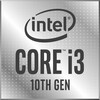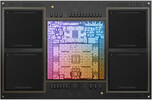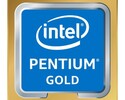Intel Core i3-10100Y vs Apple M2 Max vs Intel Pentium Gold 6500Y
Intel Core i3-10100Y
► remove from comparison
The Intel Core i3-10100Y is a efficient dual-core SoC for tablets and passively cooled laptops based on the old Amber Lake generation from 2018. It was announced in Q1 2021 and is similar to the old Core i5-8200Y. The only difference is a slightly higher GPU clock (+50 MHz).
The CPU consists of two processor cores clocked at 1.3 - 3.9 GHz. Thanks to Hyper Threading, the processor can execute up to four threads simultaneously. The chips also includes the Intel HD Graphics 615 GPU, a dual-channel memory controller (DDR3L/LPDDR3) as well as VP9 and H.265 video de- and encoder.
Architecture
Intel basically used the familiar micro architecture from the Skylake / Kaby Lake generation, so the per-MHz performance is identical.
Performance
The average 10100Y in our database is just a little ahead of the AMD 3050e, as far as multi-thread benchmark scores are concerned, the latter being an entry-level, dual-core processor of the same energy efficiency based on the Zen architecture. This makes the Core i3 an OK option for basic day-to-day activities, as of mid 2022.
Your mileage may vary depending on how high the CPU power limits are.
Graphics
The integrated Intel UHD Graphics 615 iGPU has 24 Execution Units (EUs) not unlike the older HD Graphics 515 and runs at up to 1,000 MHz. The performance heavily depends on the TDP limit as well as the memory configuration; with fast LPDDR3-1866 RAM in dual-channel mode, the GPU should sometimes be able to compete with the HD Graphics 520, but can also be much slower in other scenarios. Modern games from 2016 will, if at all, only run smoothly in the lowest settings.
Contrary to Skylake, Kaby Lake and Amber Lake now also supports hardware decoding for H.265/HEVC Main10 with a 10-bit color depth as well as Google's VP9 codec.
Power consumption
This little Core i3 here has a default TDP, also known as the long-term power limit, of 5 W that laptop makers are free to change to anything between 3.5 W and 7 W with clock speeds and performance changing accordingly as a result. Either way, the values are low and thus good enough for passively cooled tablets, laptops, mini-PCs and handhelds.
The i3-10100Y is built with one of the old 14 nm Intel manufacturing processes for low, as of early 2023, energy efficiency.
Apple M2 Max
► remove from comparison
The Apple M2 Max is a System on a Chip (SoC) from Apple that is found in the early 2023 MacBook Pro 14 and 16-inch models. It offers all 12 CPU cores available in the chip divided in eight performance cores (P-cores) and four power-efficiency cores (E-cores). The E-cores clock with up to 3.4 GHz, the P-Cores up to 3.7 GHz (mostly 3.3 GHz in multi-threaded workloads and 3.4 GHz in single threaded).
The big cores (codename Avalanche) offer 192 KB instruction cache, 128 KB data cache, and 36 MB shared L2 cache (up from 24 MB in the M1 Pro). The four efficiency cores (codename Blizzard) are a lot smaller and offer only 128 KB instruction cache, 64 KB data cache, and 4 MB shared cache. CPU and GPU can both use the 49 MB SLC (System Level Cache).
The unified memory (32, 64, or 96 GB LPDDR5-6400) next to the chip is connected by a 512 Bit memory controller (400 GB/s bandwidth) and can be used by the GPU and CPU.
The CPU performance should be quite similar to the M2 Pro as only the higher memory bandwidth and bigger L3 cache could make a difference for some workloads.
The integrated graphics card in the M1 Max offers a 30-core GPU or a GPU with all 38 cores.
Furthermore, the SoC integrates a fast 16 core neural engine (faster than M1 Max), a secure enclave (e.g., for encryption), a unified memory architecture, Thunderbolt 4 controller, an ISP, and media de- and encoders (including ProRes).
The M2 Max is manufactured in 5 nm at TSMC (second generation) and integrates 40 billion transistors. The power consumption of the CPU part is up to 36 Watt according to powermetrics. When fully loading the CPU and GPU cores, the chip uses up to 89 Watt and the CPU part is limited to 25 Watt.
Intel Pentium Gold 6500Y
► remove from comparison
The Intel Pentium Gold 6500Y is an energy-efficient, dual-core SoC designed for use in Windows tablets and passively cooled laptops. The Pentium is based on the old Amber Lake architecture that was initially introduced in 2018. The CPU was unveiled in Q1 2021; it is, in fact, not very different from Intel Core m3-8100Y, the only difference between the two being the slightly slower iGPU model (23 EU UHD Graphics 615 vs 24 EU UHD Graphics 615).
The two CPU cores run at 1.1 GHz to 3.4 GHz and are Hyper-Threading-enabled for 4 processing threads in total.
Architecture
Amber Lake family products are not known to have many improvements compared to the previous Kaby Lake and Skylake processors. They all share nearly the same per-MHz performance and nearly the same set of capabilities. Amber Lake processors do, however, have slightly higher clock speeds in comparison to their immediate predecessors.
Pentium 6500Y has a built-in dual-channel DDR3L-1600/LPDDR3-1866 memory controller as well as several PCI-Express 3.0 lanes for connecting graphics cards, SSDs and other devices. Four PCI-Express 3.0 lanes allow for read/write rates of up to 3.9 GB/s, provided a suitably fast NVMe SSD is used.
Please note this is not a user-replaceable CPU. It is supposed to get soldered permanently on to the motherboard (BGA1515 socket interface).
Performance
While we have not tested a single system built around the 6500Y as of August 2023, we have tested at least one laptop featuring the Core i3-10100Y, a chip that's just a little faster (Amber Lake, 2 cores, 4 threads, up to 3.9 GHz). Based on that, we expect the 6500Y to trail behind the AMD 3020e and the AMD 3050e just slightly. In other words, this is a very slow chip, as of mid 2023.
Graphics
The Intel UHD Graphics 615 normally has 24 Execution Units at its disposal but, for reason unbeknownst to us, just 23 EUs are active in the case of this Pentium. The graphics adapter is not much different from the HD Graphics 615 as found in 7th Gen Y-class Intel Core processors. As such, it has no support for SUHD 4320p monitors, nor can it HW-decode AV1, the latest video codec. Just the more usual VP9, AVC and HEVC are supported.
The UHD Graphics runs at 300 MHz to 900 MHz. This is not a GPU that a gamer would be happy with; very poor 3D performance is to be expected because of the thermal constraints (both Core m3-8100Y and Pentium 6500Y were created with thin tablets and ultra-thin laptops in mind) as well as the rather low TDP of the SoC. Most games will not be playable even if set to Lowest quality preset at 720p resolution. The least graphically intensive titles, like Farming Simulator 19, will pose no problem for the iGPU, though.
Power consumption
The chip is manufactured on one of the old 14 nm Intel processes for fairly unimpressive, as of late 2022, energy efficiency.
The Pentium 6500Y has a default TDP of 5 W (also known as the long-term power limit), half a watt higher than its immediate predecessors; despite the difference, a value this low makes the Pentium more than suitable for use in ultra-thin, passively cooled laptops, tablets, mini-PCs. The default TDP can be reduced slightly (with 3.5 W being the lowest Intel-recommended value) or increased (up to 7 W are possible) by laptop makers if needed, with clock speeds and performance changing accordingly as a result.
| Model | Intel Core i3-10100Y | Apple M2 Max | Intel Pentium Gold 6500Y | ||||||||||||||||||||||||||||||||||||||||||||||||||||||||||||||||||||||||||||||||||||||||
| Series | Intel Amber Lake | Apple Apple M2 | Intel Amber Lake | ||||||||||||||||||||||||||||||||||||||||||||||||||||||||||||||||||||||||||||||||||||||||
| Codename | Amber Lake-Y | Amber Lake-Y | |||||||||||||||||||||||||||||||||||||||||||||||||||||||||||||||||||||||||||||||||||||||||
| Series: Amber Lake Amber Lake-Y |
|
|
| ||||||||||||||||||||||||||||||||||||||||||||||||||||||||||||||||||||||||||||||||||||||||
| Clock | 1300 - 3900 MHz | 2424 - 3696 MHz | 1100 - 3400 MHz | ||||||||||||||||||||||||||||||||||||||||||||||||||||||||||||||||||||||||||||||||||||||||
| L1 Cache | 128 KB | 3.3 MB | 128 KB | ||||||||||||||||||||||||||||||||||||||||||||||||||||||||||||||||||||||||||||||||||||||||
| L2 Cache | 512 KB | 36 MB | 512 KB | ||||||||||||||||||||||||||||||||||||||||||||||||||||||||||||||||||||||||||||||||||||||||
| L3 Cache | 4 MB | 48 MB | 4 MB | ||||||||||||||||||||||||||||||||||||||||||||||||||||||||||||||||||||||||||||||||||||||||
| Cores / Threads | 2 / 4 | 12 / 12 | 2 / 4 | ||||||||||||||||||||||||||||||||||||||||||||||||||||||||||||||||||||||||||||||||||||||||
| TDP | 5 Watt | 79 Watt | 5 Watt | ||||||||||||||||||||||||||||||||||||||||||||||||||||||||||||||||||||||||||||||||||||||||
| Technology | 14 nm | 5 nm | 14 nm | ||||||||||||||||||||||||||||||||||||||||||||||||||||||||||||||||||||||||||||||||||||||||
| max. Temp. | 100 °C | 100 °C | |||||||||||||||||||||||||||||||||||||||||||||||||||||||||||||||||||||||||||||||||||||||||
| Socket | BGA1377 | ||||||||||||||||||||||||||||||||||||||||||||||||||||||||||||||||||||||||||||||||||||||||||
| Features | DDR3L-1600/LPDDR3-1866 RAM, PCIe 3, 4 GT/s bus, MMX, SSE, SSE2, SSE3, SSSE3, SSE4.1, SSE4.2, AVX, AVX2, BMI2, ABM, FMA, ADX, VMX, SMEP, SMAP, MPX, EIST, TM1, TM2, HT, Turbo, SST, AES-NI, RDRAND, RDSEED, SGX | ARMv8 Instruction Set | DDR3L-1600/LPDDR3-1866 RAM, PCIe 3, 4 GT/s bus, MMX, SSE, SSE2, SSE3, SSSE3, SSE4.1, SSE4.2, AVX, AVX2, BMI2, ABM, FMA, ADX, VMX, SMEP, SMAP, MPX, EIST, TM1, TM2, Hyper-Threading, Turbo, SST, AES-NI, RDRAND, RDSEED, SGX | ||||||||||||||||||||||||||||||||||||||||||||||||||||||||||||||||||||||||||||||||||||||||
| iGPU | Intel UHD Graphics 615 (300 - 1000 MHz) | Apple M2 Max 38-Core GPU | Intel UHD Graphics 615 (300 - 900 MHz) | ||||||||||||||||||||||||||||||||||||||||||||||||||||||||||||||||||||||||||||||||||||||||
| Architecture | x86 | ARM | x86 | ||||||||||||||||||||||||||||||||||||||||||||||||||||||||||||||||||||||||||||||||||||||||
| Announced | |||||||||||||||||||||||||||||||||||||||||||||||||||||||||||||||||||||||||||||||||||||||||||
| Manufacturer | ark.intel.com | ark.intel.com | |||||||||||||||||||||||||||||||||||||||||||||||||||||||||||||||||||||||||||||||||||||||||
| Transistors | 67000 Million |


 Deutsch
Deutsch English
English Español
Español Français
Français Italiano
Italiano Nederlands
Nederlands Polski
Polski Português
Português Русский
Русский Türkçe
Türkçe Svenska
Svenska Chinese
Chinese Magyar
Magyar
